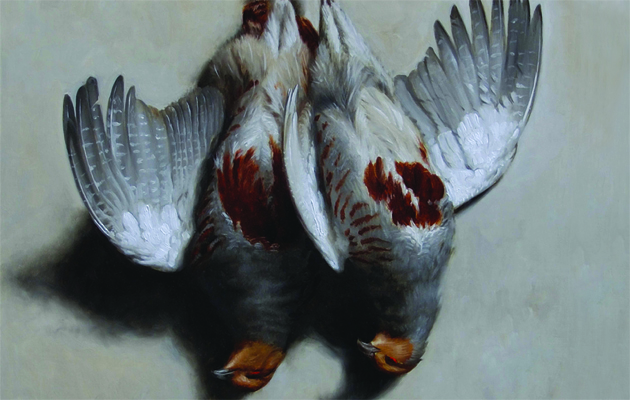For the sort of art thay will most definitely still be art tomorrow, James Gillick is the artist to go to. This year he celebrates his retrospective exhibition: 20 years. Don't miss it.
James Gillick and his exceptional work is often spotted at the Game Fair and will be on display at Burghley this year. Janet Menzies discovers what makes this sporting artist tick, and why his art is truly art. For more Field approved sporting artists see paintings by Sir Alfred Munnings and sculpture by Elliot Channer.
JAMES GILLICK
With much contemporary art, whatever the genre, the inevitable question arises: will it still be art tomorrow? James Gillick’s extraordinarily crafted oeuvre of still life, figure, portrait and equestrian paintings answers a resounding “Yes”, and, indeed, for long after tomorrow.
This month’s retrospective exhibition shows us why and how his work has been built to last. James Gillick explains, “Brought up in a house full of artists – including uncles and cousins – you grow up looking at art in a special way. Gainsborough was my first love and when it came to my own painting, I was very conscious that I wanted to produce work that I could really stand beside and feel was worthwhile.”
There is so much more to a painting than what it looks like and taste in art is subjective and changeable, so it became important to James Gillick to produce art of the highest quality on all levels. “As an artist you are trying to measure whether what you like is actually any good – but with something like a car you at least know objectively whether it is well built. I decided to make my paintings as well as I could, which meant doing a great deal of research. The materials, for example. Oil paint is very volatile, so I started reading and studying back through time to find out about this,” he says.

James Gillick’s painting Goodberry Partridge shown as a whole canvas. This is art that will still be art tomorrow.
Gillick’s research led him back to the Spanish, Flemish and Dutch masters of the 17th century, especially Velázquez. “I think you will find many artists admire Velázquez; he is a painter’s painter. I also identify with him because he had such a happy married life. I have six children and here in Lincolnshire we try to live a really natural life. In season the larder often has game hanging in it and whatever you see in one of my still life paintings has been shot locally and will be prepared and eaten in our big kitchen.”
Though heavily influenced by the Spanish bodegón style, the limited palette and subdued colours in James Gillick’s still life also have similarities with the Dutch masters. But one thing you will not see is the traditional Dutch puritan reminder of vanitas. A mouldy fruit, a bone, even a skull, was meant to remind wealthy patrons that collecting art was a vanity that no true puritan should indulge. Gillick comments, “My clients shouldn’t apologise for being able to afford my paintings. They are skilful, talented people in their own fields who have worked hard and earned the right to buy. Those who like my work are very much like the typical Field reader in that they have great respect for the natural world and a genuine, uncomplicated view of the world. I love simple, humble objects that have their own beauty and it’s important to bring out those qualities in a strong and straightforward way.”
This is particularly obvious in Gillick’s equestrian work, where his horses move in a naturalistic way, with essentially no background other than the canvas preparation. For a lover of Stubbs’s Whistlejacket, the style is irresistible. Gillick agrees: “So many of my clients actually ask me for these very simple backgrounds and especially that green-grey terre vert colour we know from Whistlejacket. But Stubbs would never have let the painting be exhibited like that. It isn’t finished! He would have passed it on to a studio apprentice to have an appropriate pastoral setting painted on. That background that we all love so much today is, in fact, the primer for the canvas. But the beauty is that it allows you to concentrate just on the animal.
“I love painting horses and I don’t think they have really been painted well for a long time. The standard, side-on ‘conformation’ pose we are so used to isn’t really at all natural for the horse and you can often see it in their eyes. I want to capture their true personality.”
Whether it is a horse in the middle of a buck and a squeal or a brace of partridges waiting to be plucked, Gillick’s paintings do get to the heart of the matter and, best of all, you don’t have to feel guilty about buying one.
James Gillick will exhibit new work alongside his Retrospective Exhibition: 20 Years, at the Jonathan Cooper Park Walk Gallery, 20 Park Walk, London, SW10 until 4 July and at Burghley Horse Trials, Lincs, from 3 to 6 September.





